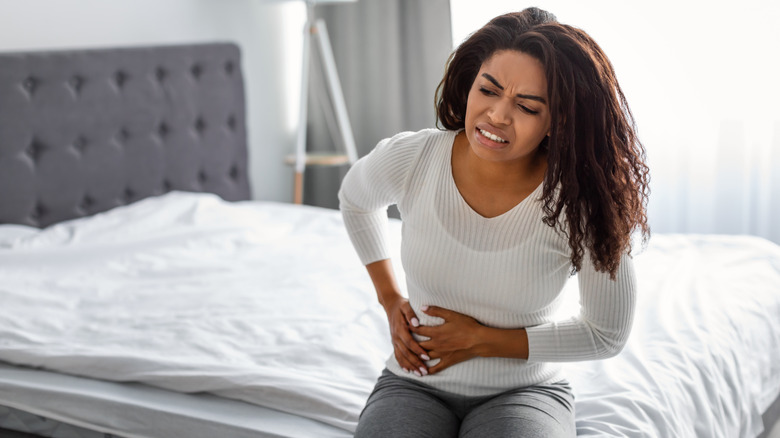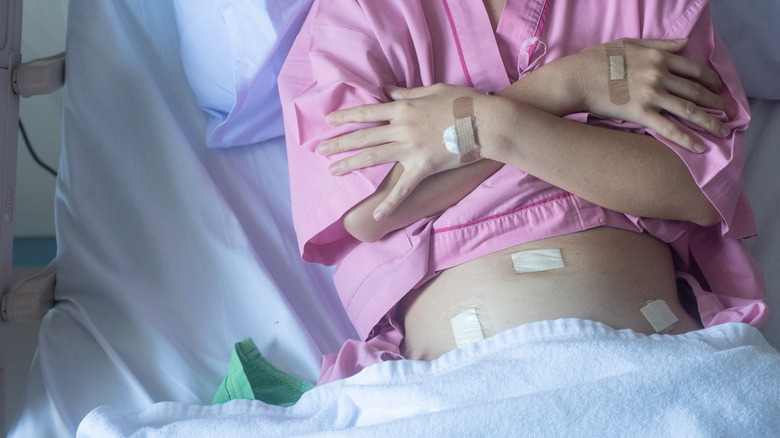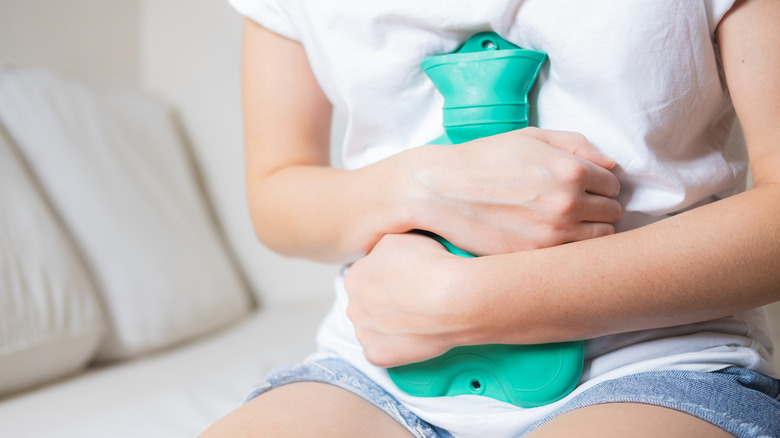Treatments That Are Available For Endometriosis
Endometriosis is a condition that affects many women and can be extremely painful. According to Johns Hopkins Medicine, between 2% and 10% of women between the ages of 25 and 40 experience endometriosis, making endometriosis a very common gynecological condition. Despite discoveries in the symptoms and side effects of endometriosis, the cause of the condition is currently unknown.
When a woman has endometriosis, the endometrial tissue that normally lines the uterus grows outside of the uterine area, per Mayo Clinic. With endometriosis, the endometrial tissue can often be found growing on the fallopian tubes, ovaries, and other areas of the pelvis and rectum. Rarely, the tissue can grow in other areas of the body. Symptoms of endometriosis can be extremely painful, with pain often being felt during the menstrual cycle, sexual intercourse, and even bowel movements. Women with endometriosis often experience very intense periods, excessive bleeding, and gastrointestinal issues like diarrhea and constipation. In many cases, endometriosis can lead to infertility.
As the medical community learns more about endometriosis, there has been an increase in treatment options for the condition. Treatments range from medication to surgery. Here are the treatments available for endometriosis and what you should know about them.
Treating the symptoms of endometriosis
There are several treatment options available for endometriosis, but there isn't a full cure for the condition at this time (per National Health Service (NHS)). Instead of eradicating endometriosis completely, available treatment options focus on decreasing the pain experienced during flare-ups, increasing fertility, removing the endometrial tissue growing outside of the uterus, and reducing the potential return of the tissue after removal. A gynecologist can help you decide the appropriate treatment for your unique needs. This will likely depend on factors such as your age, the severity of your symptoms, and whether you've previously given birth.
For pain associated with endometriosis, non-steroidal anti-inflammatory drugs (NSAIDS) will generally be the first treatment tried to reduce inflammation of the endometrial tissue and decrease pain (per NHS). There are several over-the-counter NSAIDS that can mitigate the pain associated with endometriosis, including ibuprofen and naproxen. Acetaminophen, better known as Tylenol, can also be helpful in reducing pain but won't decrease inflammation (via MedlinePlus). A trick to defeating pain related to endometriosis is to begin taking pain medications a day or two before your period begins so that you can stay on top of the pain. If, after trying over-the-counter pain medications, your symptoms are still severe or interfering with your daily life, your gynecologist may recommend additional treatment for endometriosis.
Hormonal treatments can be effective
Your gynecologist may recommend hormonal treatments like birth control pills to discourage the growth and activity of endometrial tissue, per the National Health Service (NHS). Oral contraceptive pills containing the hormones progestin and estrogen can be prescribed to potentially shrink the endometrial tissue growing outside of the uterus. In addition to birth control pills, other forms of hormonal birth control have been found to be effective in treating endometriosis. Other forms of birth control that can decrease the symptoms and growth of endometriosis include hormonal intrauterine devices (IUDs) and injectable hormones. While these treatment methods can make life with endometriosis easier, they come with their own respective side effects that you should discuss with your healthcare provider.
The Eunice Kennedy Shriver National Institute of Child Health and Human Development details how a prescription medication called danazol (otherwise known by the brand name Danocrine) can be effective in treating endometriosis. While taking danazol, the hormones typically involved in the menstrual cycle will stop being released, halting many of the symptoms of endometriosis. During treatment with danazol, you may not experience a period at all, or may only have a period very occasionally. It's important to note that hormonal birth control options aren't recommended to be taken alongside danazol. If a woman is sexually active with male partners, birth control methods like condoms are encouraged, since danazol can cause harm to a fetus.
Available surgical interventions
Surgical options are available for treating endometriosis, though they are usually only considered after trying over-the-counter pain medications and hormonal treatment methods first, per the National Health Service (NHS). There are two surgical treatment methods for endometriosis, laparoscopy and hysterectomy. Surgery is invasive, so your doctor will go over all risks and side effects with you before moving ahead with the procedure and you can ask questions beforehand. Laparoscopy is the less invasive surgical procedure and is often performed by making small incisions in the abdomen around the area of suspected endometriosis. To avoid larger incisions, the surgical team will use small cameras to transmit images to a larger screen and they will be able to assess the amount of present endometrial tissue, as well as any other concerns like ovarian cysts. During laparoscopy, the endometrial tissue will be removed and your surgeon may also remove ovarian cysts and endometriomas (cysts consisting of blood stemming from endometriosis). General anesthesia is used during laparoscopy. After the procedure, hormonal treatments may be recommended to mediate any remaining endometrial tissue and keep endometriosis from returning.
The much more invasive surgical option is a hysterectomy, which is the removal of the uterus (via WebMD). For endometriosis, a hysterectomy may involve the removal of the upper part of the uterus or the removal of the uterus and the cervix. There are many methods for performing hysterectomies, and your doctor can help you determine the best route for your needs.
Lifestyle habits for treating endometriosis symptoms
Since endometriosis can't be completely cured, incorporating lifestyle habits and learning how to manage symptoms are often recommended for creating a better quality of life with the condition. Johns Hopkins Medicine recommends taking warm baths that can reduce both pain and stress. A similar method to ease the pain is to use a heating pad, hot water bottle, or warm towel on your abdomen. However, be mindful of the hot temperatures and length of exposure to heat so that you don't burn yourself.
Exercise is a good way to simultaneously ease endometriosis pain and boost your mood (via Healthline). Additional benefits of exercising include improving sleep that might otherwise be interrupted by endometriosis-related pain and reducing constipation from endometriosis. If you're experiencing particularly severe symptoms, give the happy baby pose a go to release tension in your pelvic area. Improving your posture and mobility through physical activity can also improve symptoms, especially if the exercises you do strengthen your pelvic floor, like kegel exercises.
Activities that promote relaxation and mindfulness are also effective in alleviating endometriosis symptoms, so try doing pilates, yoga, or tai chi when you experience a flare up of endometriosis. Low-impact exercises like walking, cycling, and swimming are also good ways to combat endometriosis symptoms. A 2017 study published in the Journal of Physical Therapy Exercise discovered that exercise can dramatically decrease pain from mild to moderate endometriosis. Plus, exercise boosts endorphins, which can make you feel calmer and happier.





